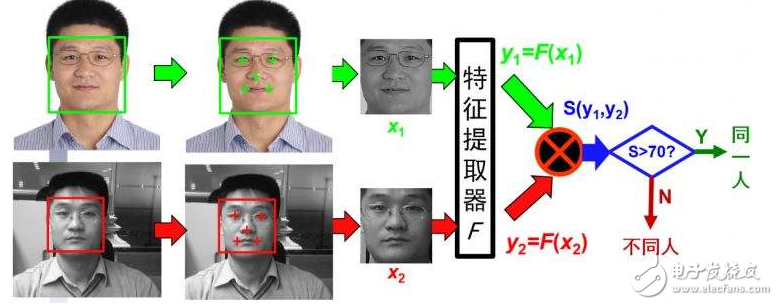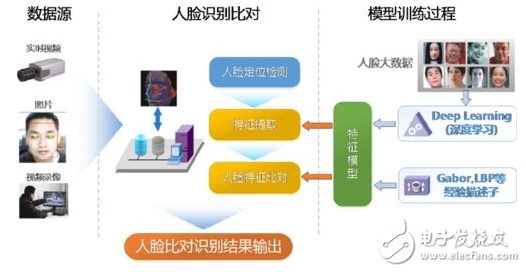Face recognition is a subdivision problem of visual pattern recognition, and it is probably the most difficult problem to solve. In fact, we are doing visual pattern recognition all the time, we obtain visual information through the eyes, and this information is recognized as a meaningful concept through the processing of the brain. So we know that there is a cup, a book, or something else in front of us. We also do face recognition all the time. We encounter countless people in our daily lives, recognize those acquaintances, greet them, deal with them, and ignore other strangers. Even avoid those who owe money and are still not available. However, this seemingly simple task is not so easy to implement for the machine. The following is a principle analysis of face recognition technology.
The principle of face recognition technology is divided into three parts:
(1) Face detection
Face detection refers to judging whether there is a face image in a dynamic scene and a complex background, and separating the face image. There are generally the following methods:
1 reference template method
First, design one or several templates of standard faces, and then calculate the degree of matching between the samples collected by the test and the standard templates, and judge whether there is a human face through the threshold;
2 face rule method
Since the face has a certain structural distribution feature, the method of the face rule is to extract these features to generate corresponding rules to determine whether the test sample contains a human face;
3 sample learning method
This method adopts the method of artificial neural network in pattern recognition, that is, the classifier is generated by learning the face image sample set and the non-face image sample set;
4 skin color model method
This method is based on the law that the skin color distribution is relatively concentrated in the color space.
5 feature sub-face method
This method treats all face image sets as one face image subspace and determines whether there is a face image based on the distance between the detected sample and its projection in the subspace.
It is worth mentioning that the above five methods can also be comprehensively adopted in the actual detection system.
(2) Face tracking
Face tracking refers to dynamic target tracking of the detected face. Specifically, a model-based approach or a combination of motion and model is used. In addition, tracking with skin color models is a simple and effective means.
(3) face comparison
The face comparison is to identify the detected face image or perform a target search in the face image library. This actually means that the sampled image is compared with the stock image in turn and the best match is found. Therefore, the description of the image determines the specific method and performance of the face recognition. It mainly uses two description methods of feature vector and face pattern template:
1 eigenvector method
The method first determines the size, position, distance and other attributes of the facial iris, nose, mouth angle and the like, and then calculates their geometric feature quantities, and these feature quantities form a feature vector describing the image.
2 face pattern method
The method is to store a number of standard face image templates or face image organ templates in the library. When performing the comparison, the sample face image is matched with all the pixels in the library using normalized correlation metrics. In addition, there is an autocorrelation network using pattern recognition or a combination of features and templates.
The core of face recognition technology is “local body feature analysis†and “graphic/neural recognition algorithm.†This algorithm is a method that utilizes various organs and features of the human face. For example, the corresponding geometric relationship multi-data formation identification parameter is compared, judged and confirmed with all the original parameters in the database. Generally, the judgment time is less than 1 second.
Principle Analysis of Face Recognition Technology - Recognition Process
Generally divided into three steps:
(1) First establish a face image of a face. That is, the camera collects the face image files of the face of the unit personnel or takes their photos to form a face image file, and stores these face image files to generate a faceprint code.
(2) Obtain the current body image. That is, the face image of the current entry and exit person captured by the camera, or taking a photo input, and generating the face image of the current face image file.
(3) Compare the current face code with the file inventory. The face code of the current face image is searched and compared with the face code code in the file inventory. The above-mentioned "face code coding" method works according to the essential features and the beginning of the face of the face. This face code is resistant to changes in light, skin tones, facial hair, hair, glasses, expressions and postures, and has a strong reliability that allows it to accurately identify a person from a million people. The face recognition process can be completed automatically, continuously, and in real time using ordinary image processing equipment.
Principle Analysis of Face Recognition Technology - Technical Process
The face recognition system mainly includes four components: face image acquisition and detection, face image preprocessing, face image feature extraction, and matching and recognition.
Face image acquisition and detection
Face image acquisition: Different face images can be captured by camera lens, such as still images, dynamic images, different positions, different expressions, etc., can be well collected. When the user is within the shooting range of the collection device, the acquisition device automatically searches for and captures the user's face image.
Face detection: In practice, face detection is mainly used for pre-processing of face recognition, that is, the position and size of the face are accurately calibrated in the image. The pattern features contained in the face image are very rich, such as histogram features, color features, template features, structural features, and Haar features. Face detection is to pick out the useful information and use these features to achieve face detection.
The mainstream face detection method uses the Adaboost learning algorithm based on the above features. The Adaboost algorithm is a method used for classification. It combines some weak classification methods and combines a new strong classification method.
In the face detection process, the Adaboost algorithm is used to select some rectangular features (weak classifiers) that best represent the face. The weak classifier is constructed as a strong classifier according to the weighted voting method, and then some strong classifiers are trained. The cascaded classifiers that form a cascade structure in series effectively improve the detection speed of the classifier.
Face image preprocessing
Face Image Preprocessing: Image preprocessing for faces is based on face detection results, processing the images and ultimately serving the feature extraction process. The original image acquired by the system is often not directly used due to various conditions and random interference. It must be pre-processed with grayscale correction and noise filtering in the early stage of image processing. For face images, the preprocessing process mainly includes ray compensation, gradation transformation, histogram equalization, normalization, geometric correction, filtering and sharpening of face images.
Face image feature extraction
Face image feature extraction: The features that can be used by the face recognition system are generally divided into visual features, pixel statistical features, face image transform coefficient features, face image algebra features, and the like. Face feature extraction is performed on certain features of the face. Face feature extraction, also known as face representation, is a process of character modeling a face. The methods of face feature extraction are summarized into two categories: one is based on knowledge representation methods; the other is based on algebraic features or statistical learning.
The knowledge-based representation method mainly obtains the feature data which is helpful for face classification according to the shape description of the face organs and the distance characteristics between them. The feature components usually include the Euclidean distance, curvature and angle between the feature points. . The human face is composed of parts such as eyes, nose, mouth, chin, etc. The geometric description of these parts and the structural relationship between them can be used as an important feature for recognizing human faces. These features are called geometric features. Knowledge-based face representation mainly includes geometric feature-based methods and template matching methods.
Face image matching and recognition
Face image matching and recognition: The feature data of the extracted face image is searched and matched with the feature template stored in the database. By setting a threshold, when the similarity exceeds the threshold, the result of the matching is output. Face recognition is to compare the face feature to be recognized with the obtained face feature template, and judge the identity information of the face according to the degree of similarity. This process is divided into two categories: one is confirmation, one-to-one image comparison process, and the other is recognition, which is a one-to-many image matching process.
Glass Curtain,Glass Curtain Display,Transparent Glass Curtain,Led Advertising Display
Kindwin Technology (H.K.) Limited , https://www.szktlled.com